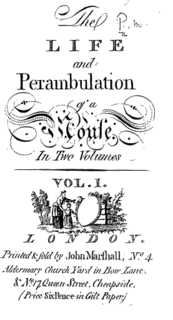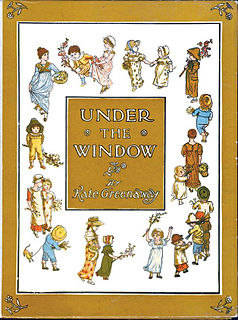
Catherine Greenaway was an English Victorian artist and writer, known for her children's book illustrations. She received her education in graphic design and art between 1858 and 1871 from the Finsbury School of Art, the South Kensington School of Art, the Heatherley School of Art and the Slade School of Fine Art. She began her career designing for the burgeoning holiday card market, producing Christmas and Valentine's cards. In 1879 wood-block engraver and printer, Edmund Evans, printed Under the Window, an instant best-seller, which established her reputation. Her collaboration with Evans continued throughout the 1880s and 1890s.

Peter Rabbit is a fictional animal character in various children's stories by Beatrix Potter. He first appeared in The Tale of Peter Rabbit in 1902, and subsequently in five more books between 1904 and 1912. Spin-off merchandise includes dishes, wallpaper, and dolls. He appears as a character in several adaptations.

The Tale of Peter Rabbit is a children's book written and illustrated by Beatrix Potter that follows mischievous and disobedient young Peter Rabbit as he gets into, and is chased around, the garden of Mr. McGregor. He escapes and returns home to his mother, who puts him to bed after offering him chamomile tea. The tale was written for five-year-old Noel Moore, the son of Potter's former governess, Annie Carter Moore, in 1893. It was revised and privately printed by Potter in 1901 after several publishers' rejections, but was printed in a trade edition by Frederick Warne & Co. in 1902. The book was a success, and multiple reprints were issued in the years immediately following its debut. It has been translated into 36 languages, and with 45 million copies sold it is one of the best-selling books in history.

The Tale of Mr. Jeremy Fisher is a children's book, written and illustrated by Beatrix Potter. It was published by Frederick Warne & Co. in July 1906. Jeremy's origin lies in a letter she wrote to a child in 1893. She revised it in 1906, and moved its setting from the River Tay to the English Lake District. The tale reflects her love for the Lake District and her admiration for children's illustrator Randolph Caldecott.

The Tale of Mrs. Tittlemouse is a children's book written and illustrated by Beatrix Potter, and published by Frederick Warne & Co. in 1910. The tale is about housekeeping and insect pests in the home, and reflects Potter's own sense of tidiness and her abhorrence of insect infestations. The character of Mrs. Thomasina Tittlemouse debuted in 1909 in a small but crucial role in The Tale of The Flopsy Bunnies, and Potter decided to give her a tale of her own the following year. Her meticulous illustrations of the insects may have been drawn for their own sake, or to provoke horror and disgust in her juvenile readers. 25,000 copies of the tale were initially released in July 1910 and another 15,000 between November 1910 and November 1911 in Potter's typical small book format.

The Tale of Mrs. Tiggy-Winkle is a children's book written and illustrated by Beatrix Potter. It was published by Frederick Warne & Co. in October 1905. Mrs. Tiggy-winkle is a hedgehog washerwoman (laundress) who lives in a tiny cottage in the fells of the Lake District. A human child named Lucie happens upon the cottage and stays for tea. The two deliver freshly laundered clothing to the animals and birds in the neighbourhood. Potter thought the book would be best enjoyed by girls, and, like most girls' books of the period, it is set indoors with a focus on housework.

The Tale of the Pie and the Patty-Pan is a children's book written and illustrated by Beatrix Potter, and published by Frederick Warne & Co. in October 1905. It tells of a cat called Ribby and a tea party she holds for a dog called Duchess. Complications arise when Duchess tries to replace Ribby's mouse pie with her own veal and ham pie, and then believes she has swallowed a small tin pastry form called a patty-pan. Its themes are etiquette and social relations in a small town.

The Tale of Benjamin Bunny is a children's book written and illustrated by Beatrix Potter, and first published by Frederick Warne & Co. in September 1904. The book is a sequel to The Tale of Peter Rabbit (1902), and tells of Peter's return to Mr. McGregor's garden with his cousin Benjamin to retrieve the clothes he lost there during his previous adventure. In Benjamin Bunny, Potter deepened the rabbit universe she created in Peter Rabbit, and, in doing so, suggested the rabbit world was parallel to the human world but complete and sufficient unto itself.

The Story of Miss Moppet is a tale about teasing, featuring a kitten and a mouse, that was written and illustrated by Beatrix Potter, and published by Frederick Warne & Co for the 1906 Christmas season. Potter was born in London in 1866, and between 1902 and 1905 published a series of small-format children's books with Warne. In 1906, she experimented with an atypical panorama design for Miss Moppet, which booksellers disliked; the story was reprinted in 1916 in small book format.

The Tale of Timmy Tiptoes is a children's book written and illustrated by Beatrix Potter, and published by Frederick Warne & Co. in October 1911. Timmy Tiptoes is a squirrel believed to be a nut-thief by his fellows, and imprisoned by them in a hollow tree with the expectation that he will confess under confinement. Timmy is tended by Chippy Hackee, a friendly, mischievous chipmunk who has run away from his wife and is camping-out in the tree. Chippy urges the prisoner to eat the nuts stored in the tree, and Timmy does so but grows so fat he cannot escape the tree. He regains his freedom when a storm topples part of the tree. The tale contrasts the harmonious marriage of its title character with the less than harmonious marriage of the chipmunk.

Ellenor Fenn was a prolific 18th-century British writer of children's books.
Frederick Warne & Co. is a British publisher founded in 1865. It is known for children's books, particularly those of Beatrix Potter, and for its Observer's Books.

Lessons for Children is a series of four age-adapted reading primers written by the prominent 18th-century British poet and essayist Anna Laetitia Barbauld. Published in 1778 and 1779, the books initiated a revolution in children's literature in the Anglo-American world. For the first time, the needs of the child reader were seriously considered: the typographically simple texts progress in difficulty as the child learns. In perhaps the first demonstration of experiential pedagogy in Anglo-American children's literature, Barbauld's books use a conversational style, which depicts a mother and her son discussing the natural world. Based on the educational theories of John Locke, Barbauld's books emphasise learning through the senses.

An alphabet book is a type of children's book giving basic instruction in an alphabet. Intended for young children, alphabet books commonly use pictures, simple language and alliteration to aid language learning. Alphabet books are published in several languages, and some distinguish the capitals and lower case letters in a given alphabet.

Edmund Evans was an English wood-engraver and colour printer during the Victorian era. Evans specialized in full-colour printing, which, in part because of his work, became popular in the mid-19th century. He employed and collaborated with illustrators such as Walter Crane, Randolph Caldecott, Kate Greenaway and Richard Doyle to produce what are now considered to be classic children's books. Although little is known about his life, he wrote a short autobiography before his death in 1905 in which he described his life as a printer in Victorian London.

John Marshall (1756–1824) was a London publisher who specialized in children's literature, chapbooks, educational games and teaching schemes. He called himself the "Children's Printer" and children his "young friends". He was pre-eminent in England as a children's book publisher from about 1780 to 1800. After 1795, he became the publisher of Hannah More's Cheap Repository Tracts, but a dispute with her led to him issuing a similar series of his own. About 1800 Marshall began publishing a series of miniature libraries, games and picture books for children. After his death in July 1824, his business was continued either by his widow or his unmarried daughter, both of whom were named Eleanor.

Toy books were illustrated children's books that became popular in England's Victorian era. The earliest toy books were typically paperbound, with six illustrated pages and sold for sixpence; larger and more elaborate editions became popular later in the century. In the mid-19th century picture books began to be made for children, with illustrations dominating the text rather than supplementing the text.

Under the Window: Pictures & Rhymes for Children was Kate Greenaway's first children's picture book, composed of her own verses and illustrations. Selling over 100,000 copies, the toy book was a commercial success, helped launch Greenaway's career as a children's book illustrator and author in the late 19th century as well as starting what became known as the "Greenaway vogue".

Illustrators of the Alice books, Alice's Adventures in Wonderland (1865) and Through the Looking-Glass (1871), number more than 100. The focus here is on English-language editions. Many other artists have created illustrations for non-English language editions. The illustrator for the original editions was John Tenniel, whose illustrations for Alice and Looking Glass are perhaps the best known illustrations ever published. This article is an ongoing attempt to list all major illustrators of the Alice books from 1899 to the present day.


















